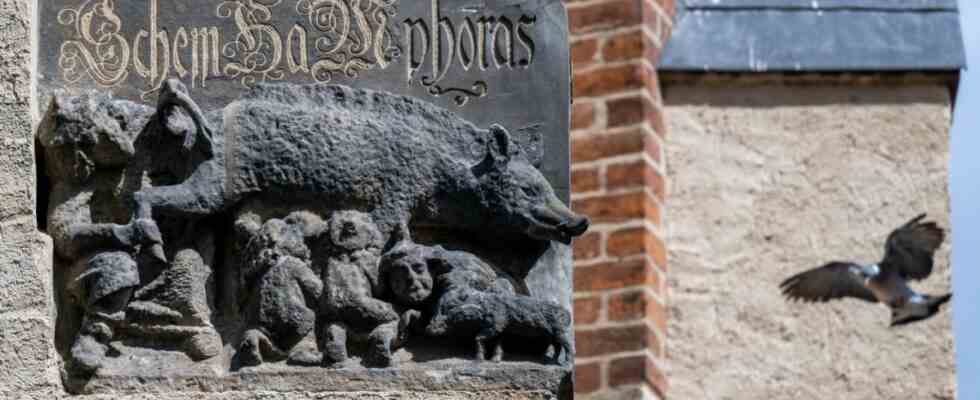The Federal Court of Justice (BGH) in Karlsruhe has heard the case of an abusive sculpture called “Judensau” at the town church in Wittenberg in Saxony-Anhalt. The court must clarify whether the sandstone sculpture must be removed. To the knowledge of the Central Council of Jews, similar sculptures exist in around fifty historic churches in Germany. The sixth civil senate wanted to examine the question thoroughly, said the presiding judge Stephan Seiters on Monday. He has not yet given a date for the forthcoming announcement of the verdict.
The Wittenberg abusive sculpture “represents a pig whose teats are being sucked by human children who are supposed to be identified as Jews by their pointy hats,” according to the Dessau district court. “A figure, also recognizable as a rabbi by his hat, lifts the pig’s tail with his hand and looks into her anus.” It is a depiction that was placed there during the lifetime of the church reformer Martin Luther, who also preached in this church. In 1570, an additional writing was carved into the stone, which is still legible today: “Schem Ha Mphoras”. That’s Hebrew, means “the special name” and is one of the many paraphrases for God common in Judaism – and at the same time the title of a book that Luther wrote in 1543 in which he equated Jews with the devil and defamed them in obscene language.
Today’s Jewish plaintiff, the 79-year-old activist Michael Düllmann, argues: The Wittenberg “Judensau” is insulting, so he has a claim for removal against the church under Section 1004 of the Civil Code. The first two court instances – the regional court in Dessau and the higher regional court in Naumburg – were not convinced of this. They reiterated that the “Judensau” representation was insulting. But today’s Wittenberg town church clearly does not adopt this statement. She lacks the “will to explain” because the relief is so old.
Distancing inscription
As early as 1988, the church had embedded a floor slab a few meters below the old “Judensau” sculpture, the inscription reads: “God’s actual name, the reviled Shem Ha Mphoras, whom the Jews held almost unspeakably holy before the Christians, died in 6 million Jews under a sign of the cross”. The first two court instances now saw this as a sufficient distancing. The regional court ruled in 2019 and confirmed the higher regional court in February 2020. But thanks to this inscription “God’s real name…” there is no longer any “declaration of the own disregard” of today’s church against Jews before.
The Anti-Semitism Commissioner of the Evangelical Church in Germany, Christian Staffa, explained: “The Wittenberg ‘Kirchensau’ is undoubtedly an insult and cannot remain so. But the long history of Christian anti-Judaism and anti-Semitism, which is obscenely condensed in this relief, is cannot be resolved through legal means.” Rather, it is about taking the church testimonies of anti-Jewish attitudes and practices as an opportunity to turn away from all anti-Semitism. “Facing anti-Jewish history and making this process visible is a long journey that has now begun, but is far from over.”

